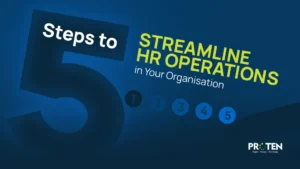In February 2022, Flavia Ziarnik, a leading procurement executive, shared her experience in a toxic work environment. It all started when the offer she applied for was rushed and seemed too good to be true (it was received and accepted in a day).
In addition to this, her job title was incorrect upon arrival. Despite these signs, she was willing to give the job her best. The next weeks saw her working long hours, including nights and weekends, on tasks that weren’t urgent.
The company she worked at prioritized short-term gain over sustainable practices. There was also a lack of communication, transparency, and respect among colleagues and leadership. The company offered low salaries but expected top performance. And management used intimidation tactics.
These are only a few amongst other things that summed up her experience. She eventually resigned after experiencing a breakdown and realizing the environment wasn’t a good fit for her.
Flavia is not the only victim of a toxic work environment.
A 2023 Fortune Research showed that 64% of workers have experienced a toxic environment. Another survey by CFO Magazine showed that 35% of employees would rather be paid less if it meant they didn’t have to work in a toxic environment anymore.
That’s alarming, isn’t it? In a landscape evolving constantly with ideas and business methods and with the mode of work that has changed trajectory since 2020, we still encounter a situation so ancient, so outdated, we believe it should be obsolete.
But it isn’t, and the reason why could be closer to you than you think. It could be you. And it most likely is. As an HR Manager, one of your responsibilities is ensuring the working conditions are suitable for everyone. Think of yourself as a movie director.
Your job is to make sure the actors in the movie play out perfect scenes. And if you don’t direct them properly, they might not be able to act out your movie the way you (and the producer) envision it. So, how do you know you’re creating a toxic work environment?
For over a decade, we’ve been a guide for HR professionals everywhere. Within this time, we coined 6 behaviors familiarly exhibited by people like you who haven’t gotten the HR thing right just yet. And these are what we’ll be sharing with you in this article.
Why is Creating a Good Work Environment So Important?
To understand a toxic work environment, you must first understand a good work environment. This way, you can know what to aim for and avoid. A good work environment is a multi-faceted thing, but at its core, it’s about creating a space where employees feel valued, supported, and empowered.
This translates into a workplace with open and honest communication, where employees feel comfortable sharing ideas and concerns without fear of judgment. It also means fostering a sense of teamwork and respect, where colleagues collaborate effectively and celebrate each other’s successes.
As an HR professional, you play a vital role in nurturing this positive atmosphere. A happy and engaged workforce is not only good for employee morale, but it also significantly impacts the company’s bottom line. You don’t need a study to tell you that positive work environments lead to increased productivity, creativity, and innovation. It’s already obvious. Engaged employees are less likely to leave, reducing costly turnover rates.
By fostering a culture of appreciation and recognition, you motivate employees to go the extra mile and contribute their best work. Furthermore, a positive environment helps attract top talent in a competitive job market. When people feel good about where they work, they become brand ambassadors, promoting the company and its values to potential new hires.
In short, fostering a good work environment is an investment in the company’s success, and your role in HR is essential to making that investment pay off.
“But How Do I Know If I’m Creating a Toxic Work Environment?”
A toxic work environment, though avoidable, is very common within the workspace. A toxic workplace is a work environment characterized by negativity, a lack of trust, and behaviours that erode employee well-being. It’s more than just a few bad days or personality clashes.
It’s a pervasive atmosphere can seriously impact your employees’ mental and physical health, productivity, and overall morale. Here are some pointers with which you can identify if you’re creating an atmosphere your workers can’t breathe in (figuratively):
1. Your Employees Keep Leaving Because of Bad Vibes.
Employee turnover costs companies a lot of money, with resignation being the leading cause of growing turnover rates. In a study carried out by iHire on over 3700 job seekers, 35.7% of employees left their former jobs due to terrible work environments.
Turnover rates are expected to see an increase in the coming years, with employees, particularly from the younger generation, prioritizing career advancement and work experience. Nobody wants to walk into an office where negativity hangs like a thick fog.
A continuous cycle of complaints, gossip, and general bad vibes, is a breeder of discontentment. Over time this translates to your employees seeking greener pastures, leading them to send in their resignation letters before you can blink. And you can’t complain. It’s aura for aura.
So what does this mean for you?
Well, you might need to take a step back and have a hard look at your leadership style. Do you lead by example with a positive mindset, or do you find yourself contributing to the negativity by being part of the complainers? And even if you lead with positivity, do you swiftly address negativity, or leave it unchallenged? High turnover is also a wake-up call.
While some turnover is natural, a consistently high rate suggests a deeper issue in your workplace culture. Consider conducting exit interviews to understand why your employees are leaving. That way you can know if you’re part of the “weapons fashioned against them”.
2. Your Employees Don’t Feel Safe, Psychologically.
No, this does not mean that they have run mad. Psychological safety is the feeling your employees get when they know they can speak up on issues that bother them, without being condemned for it. It also means they can share ideas for the betterment of the company with the confidence that they will be recognized for it and said idea will not pass off as someone else’s own.
In addition to this, it means that they can take calculated risks without the fear of punishment and humiliation. Psychological safety is the cornerstone of a healthy and productive work environment. It contributes to higher levels of engagement by fostering a culture of trust and respect.
As a matter of fact, studies have shown an intimate relationship between psychological safety and productivity. In a toxic environment, this safety net is ripped away. Employees become afraid to voice their opinions, fearing ridicule, criticism, or being passed over for promotions.
This stifles creativity, innovation, and problem-solving. Imagine a team meeting where everyone sits silently, unwilling to offer suggestions because they’re afraid of being the target of your scathing remark. This not only wastes valuable brainpower but also hinders the team’s ability to learn and grow.
So what should you reflect on?
Do your employees seem hesitant to participate in meetings or offer suggestions in brainstorming sessions? Do they jump at your every word, afraid to make mistakes? These are signs of a culture of fear. Here’s how to break the cycle: Actively listen to concerns, encourage healthy debate, and praise employees for taking risks (even if they don’t always succeed). Celebrate “learning moments” from mistakes instead of dwelling on blame.
3. You Find Yourself Micromanaging.
Short of an employee being in a performance improvement plan to prevent them from being fired, there should be no reason for you to micromanage your employee. Micromanagement, the act of controlling every aspect of an employee’s work, is a recipe for disaster.
Do you find yourself constantly checking in, hovering over shoulders, and second-guessing decisions? While providing clear direction is important, micromanagement sends a clear message: you don’t trust your employees to do their jobs.
This breeds resentment, disengagement, and a sense of being incompetent. It stifles your employee’s creative ability, and their motivation and sense of ownership over their work will inevitably plummet.
Take a step back and ask yourself:
Do you delegate tasks effectively, or do you find yourself holding onto things you could let go of? Trust your employees to be professionals. Provide clear expectations and goals, but give them the autonomy to achieve them in their way.
Offer support and guidance when needed, but don’t micromanage every step. This empowers your team, fosters a sense of ownership, and ultimately leads to better results.
4. Communication Is One-Sided, and There’s an Ongoing Blame Game.
Effective communication is a two-way street, yet in a toxic environment, information often flows in one direction only: from you to your team. Employees are left feeling unheard and undervalued. This lack of transparency fosters a culture of suspicion and distrust.
Furthermore, a toxic environment often involves a never-ending blame game. When mistakes happen, the focus shifts to finger-pointing and accusations instead of finding solutions and learning from the experience. Imagine working on a project where every setback is met with a barrage of blame. This is a recipe for frustration and disengagement.
So what should you ask yourself?
Do you encourage open communication and feedback from your team? Do you hold regular meetings where employees feel comfortable sharing ideas and concerns? When mistakes happen, do you focus on finding solutions and learning from the experience, or do you assign blame?
Here’s the key: create a culture of open communication where everyone feels comfortable speaking up. Embrace a “growth mindset” where mistakes are seen as opportunities to learn and improve.
5. There Seems To Be Partial Treatment and a Lack of Recognition.
Playing favorites is a surefire way to create a toxic environment. If you have clear favorites who receive preferential treatment and promotions, it sends a demoralizing message to your employees: “Your hard work and dedication are not valued”. Equally damaging is a lack of recognition for good work.
When a job well done goes unnoticed or unappreciated, your employees become demotivated and feel undervalued. Imagine pouring your heart and soul into a project only to have it met with silence. This not only extinguishes your enthusiasm but also sends a message to others that putting in extra effort is pointless.
So what does this mean for you, and what should you reflect on?
Do you treat all your employees fairly and consistently? Here’s a self-assessment: Do you take the time to acknowledge and appreciate the contributions of all your team members, or do your compliments flow freely to a select few? Ensure clear and fair promotion policies are in place, and celebrate the successes of all your employees, not just a select few.
A simple “thank you” or a public shout-out can go a long way in boosting morale and showing your team that their hard work is valued.
6. Your Employees Are Exhausted.
And this is because of burnout and a lack of work-life balance. Burnout is a state of emotional, physical, and mental exhaustion caused by prolonged or excessive stress. A toxic work environment is a breeding ground for burnout.
Unrealistic workloads, constant pressure to perform, and a lack of respect for personal time all contribute to this state. You can’t expect your employees to be available 24/7, with no clear boundaries between work and personal life. This constant pressure will lead to exhaustion, health problems, and ultimately, a decrease in productivity.
So what does this mean for you?
Ask yourself, do your employees seem perpetually stressed and overwhelmed? Do they work long hours and rarely take breaks? Do they seem constantly “on,” checking emails and responding to messages outside of work hours? Here’s how to break the cycle: Review your workload expectations. Ensure they are realistic and achievable. Encourage your team to take breaks and use their vacation time. Lead by example and disconnect after work hours.
Most importantly, set clear boundaries between work and personal life for both yourself and your employees. A well-rested and healthy team is a productive team. It’s very important to let the employees breathe.
How Can You Properly Access Yourself?
You can’t just assume that your employees are unsatisfied with their environment. Here are some ways you can measure the satisfaction of your employees:
I. Anonymous Feedback.
While your role allows you to give feedback freely, some of your employees may not be able to. Create anonymous surveys to gather honest feedback from employees about communication, workload, leadership style, and overall work environment. In addition to this, implement a suggestion box (physical or online) where employees can anonymously submit feedback and concerns. This way, your employees can give their honest feedback without the fear of being targeted by anyone.
II. Become an Active Observer.
And no, we don’t mean you should stalk your employees every move. That might be translated to either micromanagement, or a legal case. What you should do instead, is to pay attention to nonverbal cues during meetings or interactions. Are your employees making eye contact? Do they seem engaged or withdrawn?
In addition to this, you should maintain an open-door policy and encourage employees to come to you with concerns. Be approachable and genuinely interested in their feedback. Furthermore, when your employees do speak up, be ready to listen actively without interrupting. Show that you value their perspective and take their concerns seriously.
III. Solicit Feedback From Peers.
If you have any colleagues you look up to or parole with, confide in them, or your mentors, for their honest feedback on your leadership style and how you interact with your team. Also, consider implementing 360-degree reviews where you receive feedback from superiors, peers, and subordinates. This can provide a well-rounded perspective on your strengths and weaknesses.
IV. Review Employee Performance Metrics.
A high turnover rate can be a red flag for a toxic work environment. Analyze exit interview data to understand why employees are leaving. In addition to this, look for trends in employee engagement surveys. Are there areas where morale seems low or satisfaction is dropping?
V. Self-Reflection.
Take time to reflect on your interactions with your team. Journaling can help you identify patterns in your behavior and areas for improvement. It’s also important to evaluate your emotional intelligence. Do you manage your own emotions effectively? Are you empathetic to the needs and concerns of your employees?
By incorporating these self-assessment tips, you can gain valuable insights into your leadership style and the overall health of your work environment. Remember, creating a positive and productive work environment is an ongoing process. Be open to feedback, be willing to adapt, and prioritize the well-being of your team.
Now That You’ve Accessed Yourself, What’s The Next Step?
The next step is to change. Intentionally. Once you’ve identified areas for improvement, take immediate action! Focus on open communication by holding regular meetings and encouraging employee feedback. Delegate tasks effectively and empower your team by trusting them to make decisions. Promote a healthy work-life balance by setting clear boundaries and encouraging breaks and vacation time. Recognize and reward achievements to boost morale.
Finally, foster a culture of learning and growth by embracing a “growth mindset” and focusing on solutions over blame. If need be, provide avenues where your employees can learn technical and interpersonal skills through workshops and training initiatives.
By implementing these changes, you can move forward from creating a toxic work environment and build a positive and productive team.
In Conclusion…
A healthy and positive work environment isn’t just about perks and salary. It’s about fostering trust, respect, and psychological safety. By recognizing the signs of a potentially toxic environment you might be creating and taking proactive steps to address them, you can become a leader who empowers your team and fosters a space where everyone is productive.
A positive work environment benefits everyone. Happy, engaged employees are more innovative, creative, and less likely to leave. This translates to lower turnover costs, a stronger employer brand, and ultimately, a more successful organization.
If you’re unsure where to start or need help implementing changes, don’t hesitate to seek guidance. Our HR Advisory services offer a range of solutions to help leaders cultivate positive work environments.
With our customized solutions tailored to your specific needs and challenges, we’ll help you track your performance and improve over time. Contact us today to learn more about how we can help you on your journey to betterment.










